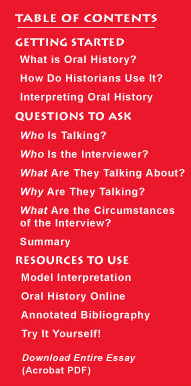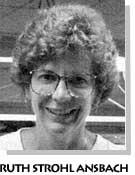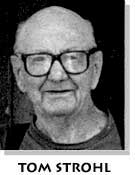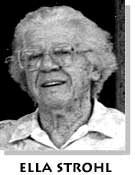talking history | syllabi | students | teachers | puzzle | about us

|
What a narrator says, as well as the way a narrator says it, is related to that person's social identity (or identities). Who a narrator is becomes a cognitive filter for their experiences. Recognizing the differing social experiences of women and men, feminist historians have noted that women more so than men articulate their life stories around major events in the family life cycle, dating events in relation to when their children were born, for example. Men, on the other hand, are more likely to connect their personal chronologies to public events like wars, elections, and strikes. Women's narratives also tend, as Gwen Etter-Lewis has put it, towards "understatement, avoidance of the first person point of view, rare mention of personal accomplishments, and disguised statements of personal power."* Racial identity, too, figures into oral historical accounts. Writing about the 1921 race riot in Tulsa, Oklahoma, Scott Ellsworth coined the phrase "segregation of memory" to describe the varying ways blacks and whites remembered this gruesome event.* It is a typical pattern, suggestive of the deep racial divides in the United States. In interview after interview, whites recalled either "very little at all" about members of minority groups or that "we all got along," while members of minority groups tended toward both a more nuanced and less sanguine view of white people. Interviews with politicians and other notable public figures pose particular problems. While they are perhaps no more egocentric or concerned about their reputations than many others, their practiced delivery and ability to deflect difficult questions often leads to accounts that are especially facile and glib. Indeed, the general rule of thumb is the longer a public official has been out of the public eye, the more honest and insightful the interview will be. One can catalogue any number of ways different "whos" inflect oral history narratives. Yet identities are neither singular nor fixed. "Who" exactly is speaking is defined by both the speaker's relationship to the specific events under discussion and temporal distance from them. Hence while we would expect labor and management to record differing accounts of a strike, union members too can differ among themselves, depending upon their relative gains or losses in the strike's aftermath, their differing political views and regard for authority, or their differing levels of tolerance for the disorder a strike can create. And their views can change over time, as perspectives broaden or narrow, as subsequent experiences force one to reconsider earlier views, as current contexts shape one's understanding of past events. All are part of who is speaking.
|
||||||||||||

|
|||||||||||||





